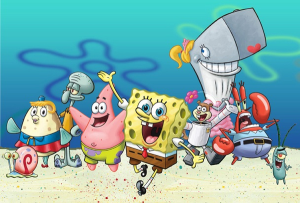
Photo from: https://en.wikipedia.org/wiki/SpongeBob_SquarePants
If you’re a millennial, then you may be very familiar with the popular animated Nickelodeon television series, SpongeBob SquarePants, that ran 9 seasons from 1999 until 2012, was made into two animated films (with another in the works), and was also made into two television films!
If you do know of SpongeBob, the sea sponge that lives in a pineapple under the sea, then you know of the other vital characters, like his best friend, Patrick Star, the starfish that lives under a rock; Squidward Tentacles, his miserable neighboring octopus; and Mr. Krabs, Spongebob’s greedy employer at the Krusty Krab, the fast food restaurant known for its Krabby Patty burgers.
In January 2016, Viacom International Inc. (formerly MTV Networks) sued IJR Capital Investments (IJR) for copyright infringement, due to IJR registering the trademark “Krusty Krab” and planning to open a restaurant with that name. This hits close to home, because IJR wanted to open the restaurant right here in Houston, Texas! When Viacom discovered this, they sent IJR a cease and desist letter requesting that they change the name of the restaurant and to not use any Spongebob marks. IJR responded that they did not think that the name would cause confusion and that they also would not stop using the name. Viacom owns Nickelodeon TV network and feared that the restaurant would dilute the name of the “Krusty Krab” and infringe upon the trademark, even though Viacom never registered the “Krusty Krab” with the U.S. Patent and Trademark Office.
Thus, the lawsuit ensues. The court concluded that “Krusty Krab” is a valid trademark, even though it was never registered. Here’s why! The “Krusty Krab” has been featured in 166 of 203 episodes of the television show and in the two SpongeBob SquarePants films. This proved that it was a valid mark based on its use in commerce.
IJR argued that Viacom never registered the mark, and it’s a fictional restaurant. The court agreed with Viacom that trademark protection extends to important symbols, design elements, and characters within a television show, and that it was distinctive through secondary meaning. The seven-factor test determined that it was distinctive: (1) length and manner of use of the mark or trade dress, (2) volume of sales, (3) amount and manner of advertising, (4) nature of use of the mark or trade dress in newspapers and magazines, (5) consumer-survey evidence, (6) direct consumer testimony, and (7) the defendant’s intent in copying the mark.
The court proved that the mark is valid and distinctive, and Spongebob and his friends win this case!
Thank you for letting us know of this case, Maryann!
#OwnYourMark #MakeYourMark
Written by: Teresa Nguyen
